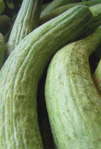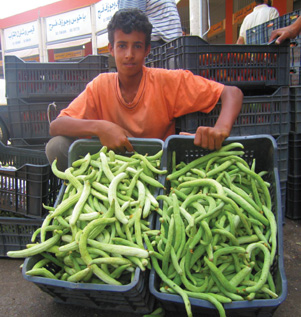

Snake cucumber at market near Nahr el Kalb, Lebanon. Courtesy Houssam Shaiban
NEITHER THE QURAN NOR THE Bible explains the term “vegetable.” Therefore, we are dependent on archaeological research that has shown what was eaten in western Asia at the time the Bible and the Quran were written. Interestingly, the most comprehensive list of vegetables—if it can be called that—is from the malcontent Children of Israel who, after leaving Egypt, desired the vegetables that they had left behind and complained to Moses. The incident is mentioned in both scriptures. In the Quran: “O Moses, we are tired of eating the same food, ask your Lord to give us fruits of the earth, herbs and cucumbers, grains and lentils and onions” (Sura 2:61, Ali). And in the Bible: “We remember the fish we ate in Egypt at no cost—also the cucumbers, melons, leeks, onions and garlic” (Numbers 11:5, NIV). Despite widespread cultivation of these vegetables in Bible times, this is the single mention of them, all well known then except for “cucumbers.”
Because the common garden cucumber, Cucumis sativus, is generally thought to have originated in India and was not widely cultivated in the Middle East until the beginning of the Christian era (Zohary and Hopf 2000, Murray 2000), it is an unlikely Bible plant. Rather, the cucumber mentioned is actually a kind of melon, called chate melon, Cucurbita pepo var. flexuosus, also known as Cucurbita pepo subspecies ovifera, eaten as a cucumber. Its flavor is milder than that of the common garden cucumber and the flesh is firmer.
Snake cucumber with flowers and developing fruits, in July, Tel Hadya, Syria. Courtesy Atef Haddad.

Snake cucumbers arriving at market in Lebanon. Courtesy Houssam Shaiban.
Common in Sudan and Egypt, where it is known in Arabic as ajjour, this cucumber usually grows coiled, hence the English name “snake cucumber.” When I lived in Sudan, ajjour was the only cucumber available in the market, with large specimens up to almost 1 meter (3 feet) long. In Lebanon, Cucurbita pepo var. flexuosus is also commonly grown and known as mekteh; there the young, small cucumbers are often pickled. Apparently, snake cucumber was grown at one time in Europe (Janick and Paris 2006).
The “vegetable verse” in Numbers 11 is often viewed as the produce section of the Bible, and to a large extent that is true. The “cucumber” in this verse, however, is not a cucumber but a relative of the cantaloupe.